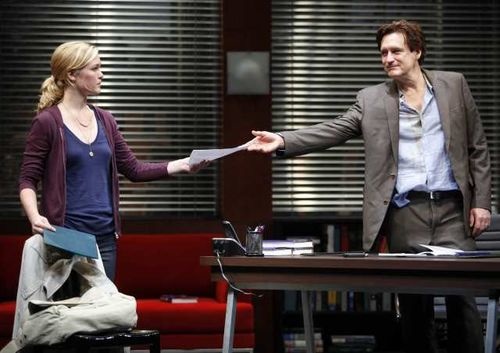Ben Brantley puts the Mamet back into Mamet

"As staged by Mr. Hughes, the current “Oleanna” flies bravely in the face of Mr. Mamet’s prescriptions about acting. “There is no character,” Mr. Mamet has written. “There are only lines upon the page.” This “Oleanna” squints to read between those lines, and Mr. Pullman and Ms. Stiles have obviously been encouraged to create characters who are more than what they say."
by Michael Wheeler
Although material on the Praxis Website usually refrains from mentioning or linking to reviews, famed New York Times theatre critic Ben Brantley’s review of the recent Oleanna revival in NYC is interesting enough to be come the exception that proves this rule.
In his review, Brantley makes the argument that the production starring Bill Pullman and Julia Stiles is not a success in large part because the performers do not use the correct acing technique: a Practical Aesthetics approach to performing the text developed by Mamet and taught by the Atlantic Theatre Company he helped to found.
The original production of Oleanna starring Rebecca Pidgeon (who is married to Mamet) and Practical Aesthetics co-creator William H Macy, “seemed to move at warp speed” and left Brantley, “with shortened breath and heightened blood pressure”. The current production he writes, “seemed slow to the point of stasis, and its ending found me almost drowsy.” Both productions had roughly the same running times.
Creating a complictaed and contradictory character is not normally a flaw in the approach of a performer. A medium still heavily influenced by Stanislavsky and Psychological Realism normally rewards those artists that create multi-layered characters who are “more than what they say”. In fact, not to do so in many post-Chekovian texts is to risk one-dimensionality – it is assumed that the process of creating a character includes plumbing the world between the lines to create the fully formed human being within.
Brantley argues that this is not however, the approach that should be taken with this text:, “because “Oleanna” is a play about people for whom language is a conditioned reflex: They don’t think before they speak, even when they believe they do.” This – in a nutshell – is the essence of the technique that Mamet and Macy have worked to develop. In direct response to what they refer to “the method”, Practical Aesthetics forces the actor rely on their will over their intellect by distilling the creation process to a three step process that prizes the text over all else.
Because I haven’t seen the production, it’s impossible for me to have an informed opinion about Brantley’s analysis. I broke one of the few rules of curating material for this site because I was struck by a review of a piece of theatre that was conscious of not only what elements the production succeeded and failed, but posited informed reasons why they did as they related to the craft and approach the artists used to create it. It seemed to me rare, insightful, and good evidence as to why having your show reviewed in The Times still matters a little more than all the rest.
Click the link to read the full review: He Said, She Said, but What Exactly Happened?


While I generally agree with Brantley’s post, I feel obliged to point out that he’s conflating “technique” with “style”. That Mamet’s plays are written with a particular style in mind (consisting largely of the pace of the dialogue,) they do not dictate the actors’ technique; conversely, using Mamet’s acting technique does not necessitate performing a scene in a particular style.
If Mamet’s technique suits his plays, it’s because his plays are (mostly) well-written stories, and his acting technique is an effective means for bringing a story (any story) to life.